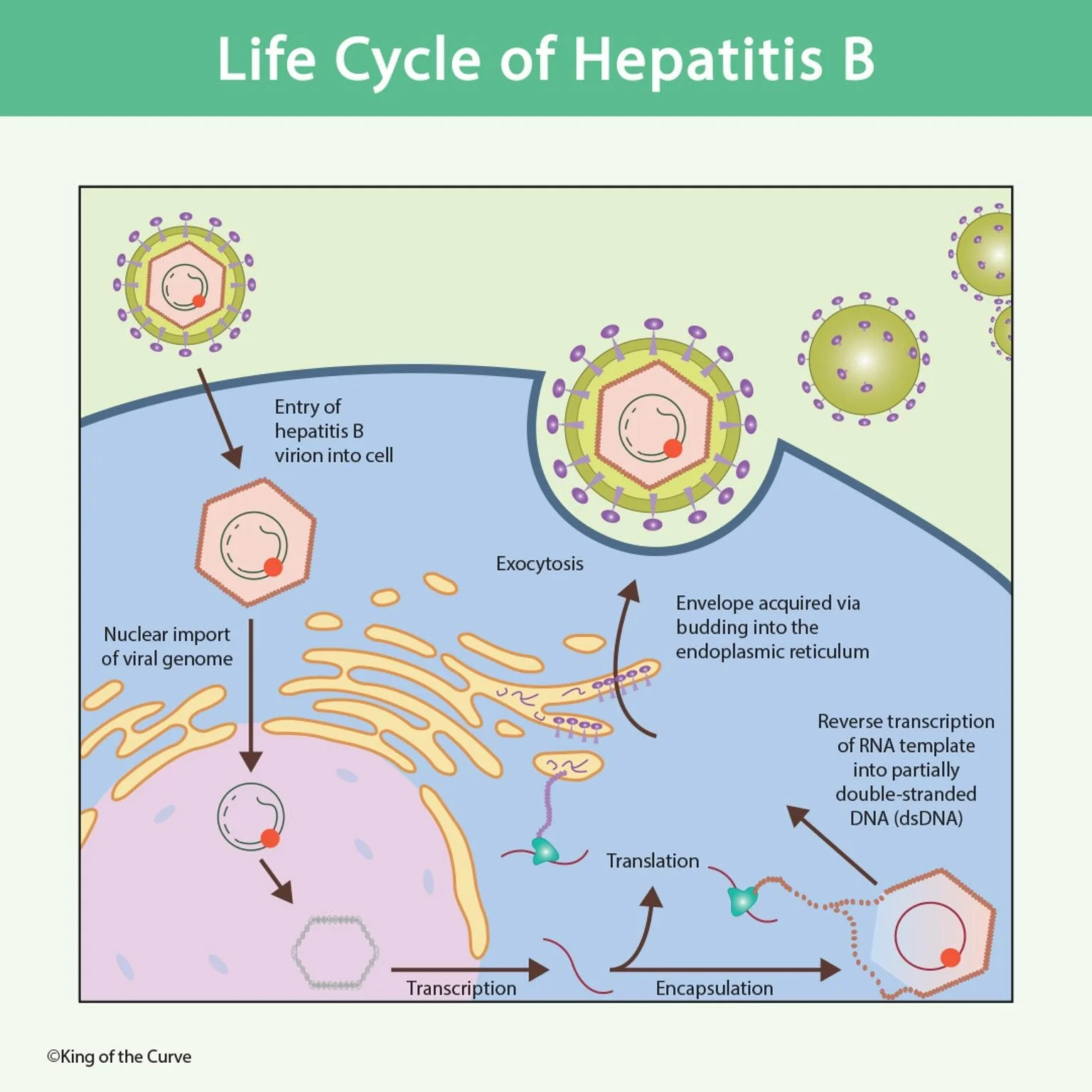🧬 Life Cycle of Hepatitis B: From Infection to Replication
Hepatitis B virus (HBV) is one of the most studied and clinically significant viruses in medicine.
It’s a DNA virus that infects the liver, causing diseases that range from acute infection to chronic hepatitis, cirrhosis, and even hepatocellular carcinoma (HCC).
Understanding its life cycle helps explain how antiviral drugs work — and why complete eradication of HBV from infected cells is so difficult.
🔄 Step-by-Step: Life Cycle of Hepatitis B
1️⃣ Viral Entry
The Hepatitis B virion binds to hepatocyte receptors and enters the cell by endocytosis.
Its nucleocapsid releases the viral DNA into the cytoplasm.
2️⃣ Nuclear Import
The partially double-stranded DNA (rcDNA) is transported into the nucleus.
Host enzymes repair it into covalently closed circular DNA (cccDNA) — a stable form that persists for years, acting as a template for transcription.
3️⃣ Transcription
The host’s RNA polymerase II transcribes the cccDNA into various viral mRNAs, including the pre-genomic RNA (pgRNA).
4️⃣ Translation
Viral proteins such as HBsAg (surface antigen) and HBcAg (core antigen) are synthesized from the mRNAs in the cytoplasm.
5️⃣ Encapsulation and Reverse Transcription
The pgRNA is packaged into new nucleocapsids, where reverse transcriptase converts it back into partially double-stranded DNA (dsDNA) — similar to how retroviruses work.
6️⃣ Maturation and Release
The nucleocapsid buds into the endoplasmic reticulum, acquiring its lipid envelope.
Mature virions are then released from the cell by exocytosis, ready to infect new hepatocytes.
📊 Quick Summary Table: HBV Life Cycle Steps
| Stage | Key Event | Location | Clinical Importance |
|---|---|---|---|
| Entry | HBV virion attaches to hepatocyte | Cytoplasm | Target for entry inhibitors |
| Nuclear Import | rcDNA repaired to cccDNA | Nucleus | cccDNA persistence → chronic infection |
| Transcription | mRNA and pgRNA produced | Nucleus → Cytoplasm | Target for RNA interference therapies |
| Reverse Transcription | pgRNA → dsDNA inside capsid | Cytoplasm | Blocked by reverse transcriptase inhibitors (e.g., Tenofovir) |
| Assembly & Exocytosis | Virion forms and exits | ER → Cell membrane | Produces HBsAg (diagnostic marker) |
💡 MCAT/USMLE Tip:
HBV is a partially double-stranded DNA virus that uses reverse transcription, making it unique among DNA viruses — and a favorite exam question!
⚕️ Clinical Relevance
HBsAg (Hepatitis B surface antigen): Appears first in infection; persistence >6 months indicates chronic hepatitis.
Anti-HBc antibody: Indicates prior exposure or infection.
HBV DNA levels: Reflect active viral replication and guide treatment decisions.
Antiviral Therapy: Targets reverse transcription (Tenofovir, Entecavir) to suppress viral DNA synthesis.
💡 USMLE Insight:
cccDNA persistence explains why HBV cannot be completely eradicated by current antiviral therapy — only suppressed.
🧩 Exam Connections
MCAT: Focus on viral structure and nucleic acid replication mechanisms.
USMLE Step 1: Mechanism of reverse transcription and clinical markers of infection.
NCLEX: Nursing priorities for managing chronic hepatitis and preventing transmission.
🌍 Beyond the Exam: Why It Matters
Hepatitis B affects over 250 million people worldwide, with over 800,000 deaths per year from complications like cirrhosis and liver cancer.
Understanding its replication cycle is the foundation for developing vaccines, antivirals, and potential curative therapies.
🔑 Call to Action
Learning complex viral mechanisms becomes simple with King of the Curve’s adaptive visuals.
Boost your comprehension with animated science graphics, MCAT-style questions, and Curve Coins gamification.
Frequently Asked Questions (FAQs)
-
Aim for 4-6 focused hours, ensuring you incorporate breaks to avoid burnout.
-
Practice mindfulness techniques, take practice exams under realistic conditions, and maintain a balanced lifestyle.
-
Set short-term goals, seek support from mentors, and reward yourself for small achievements.
-
Regular exercise improves focus, reduces stress, and enhances overall mental clarity.
-
KOTC offers personalized learning tools, gamification features, and adaptive question banks to help students stay on track without burnout.


